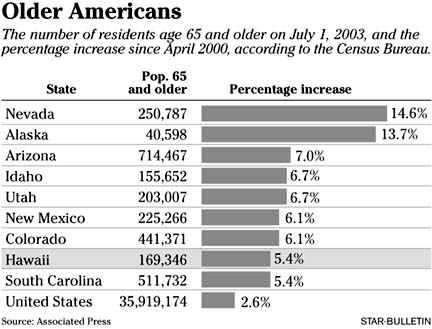
Isles rank high
in rise of seniorsHawaii is among the top
eight states for growth in the
over-64 population segment
While construction crews continue to put up garden walls and plant yellow hibiscus, seniors have already leased all 32 units of low-income rental housing at Kaluanui Senior Housing in Hawaii Kai.
"The percent of seniors within the Hawaii population is rising exponentially," said Mike Allison, president of Hawaii Intergenerational Community Development Association, a nonprofit housing developer that built the Hawaii Kai senior housing.
Allison plans to break ground this summer on a 70-unit low-income rental complex in Nanakuli.
"We're seeing a huge demand for senior housing," he said. "A hell of a lot of people were born in the 1940s and 1950s and they are living longer."
With a 5.4 percent increase in its senior population between 2000 and 2003, Hawaii ties for sixth place (with South Carolina) in the nation for having the greatest percentage increase in the 65-and-over age group, according to U.S. Census Bureau figures released yesterday.
Hawaii's senior population totals 169,346, according to the figures.
Nationally, the senior population rose almost 3 percent to 35.9 million. Even faster-growing is the 85-and-over age group. Nationally, that group rose 11 percent to 4.7 million from 4.2 million.
Nevada, which leads the nation in most population growth segments, is also the top-ranked state for growth among seniors, with a 15 percent increase between 2000 and 2003. In the 85-and-over crowd, Nevada saw a 30 percent increase.
Alaska ranks second with a 14 percent increase in seniors, followed by Arizona, long a popular retirement destination, which ranks third with a 7 percent increase.
Some demographers say states such as Arizona, Utah, New Mexico, Nevada and Idaho show growth among seniors in large part because they attract seniors looking for warm or moderate weather and a lower cost of living.
But some demographers attribute the high percentages of seniors in Hawaii and Alaska, where the cost of living tends to be higher, to the aging of their own residents rather than retirees moving in.
"Hawaii is getting people aging in place," said Mark Fagan, a sociologist at Jacksonville State University in Florida who specializes in retiree migration.
He noted that people are living longer due to advances in medicine and healthier lifestyles.
"It used to be the first chronic disease -- cancer or a heart attack -- that hit you, killed you," he said. "Now people are surviving."
People don't move away from Hawaii probably because "it's a great climate and people have strong family ties and don't want to move away from kids and grandkids," Fagan said. "It's part of the culture."
If Hawaii is getting migrations of seniors, they are likely to be upscale ones from California, he said.
By far the most populous state, California has the largest number of people 65 and over at 3.8 million, a 4.7 percent increase between 2000 and 2003.
Pat Sasaki, director of the state Office on Aging, agreed that most of the migration to Hawaii is likely to be "upscale members of the aging boomer population."
Sasaki also said the state estimates that 20 percent of Hawaii's adult population is providing care to someone age 65 or older.
